Mary Cronk Farrell's Blog, page 15
February 1, 2015
Share Your Gratitude, Let's Celebrate Together!
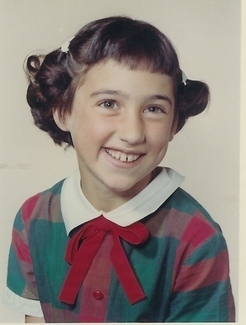 My 9-year-old self is squealing with glee!
My 9-year-old self is squealing with glee!My book PURE GRIT appears in this month's Scholastic Reading Club form in schools across the country. This may be the most exciting thing yet in my writing career.
When my elementary school teachers passed out those book club flyers, I couldn't wait to look through and see what books were available. I usually could only afford one book each month, so sometimes the decision was rough going.
Nothing compared to seeing the box arrive, my teacher slitting the tape, the books coming out and one getting passed into my hands. Maybe my dream of writing books for kids started right there.
Scholastic buys the rights to publish cheaper paperback editions of books for the reading club, to make it easier for kids to own their own books. Teachers pass out the order forms and students can bring money to school or their parents can purchase the books online.

Scholastic awards points to teachers for all the books their students purchase. Teachers can use these points to buy books for their classrooms.
I'll take this opportunity to acknowledge that a book is a team effort, and to thank the team that produced PURE GRIT.
From the moment I discovered these amazing WWII Nurses through to the book hitting the shelves, I had continual, generous, aid and support from many other people.
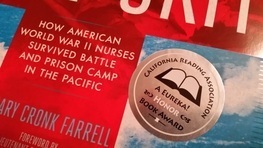 Since the advent of e-mail, going to the mailbox has lost most of its excitement and gravitas. So it was a red letter day when I received the envelope from my publisher containing a strip of silver stickers. I had know that PURE GRIT had been named a 2014 Eureka! honor book, but it really hit home when I stuck that sticker on the cover.
Since the advent of e-mail, going to the mailbox has lost most of its excitement and gravitas. So it was a red letter day when I received the envelope from my publisher containing a strip of silver stickers. I had know that PURE GRIT had been named a 2014 Eureka! honor book, but it really hit home when I stuck that sticker on the cover.The California Reading Association established the Eureka! Nonfiction Children’s Book Award to celebrate and honor nonfiction children’s books and to assist teachers, librarians, and parents in identifying outstanding nonfiction books for their students and children. Click here to see all the books on the list.
Also, thank you to readers, librarians, teachers, and Veteran's organizations--I am humbled by your response to the book.
I'm appreciative of so much love and support for PURE GRIT.
You are all helping to bring these WWII Nurses the honor and attention they so greatly deserve.
Published on February 01, 2015 10:55
January 22, 2015
Computer Science Man of the Year...was a Woman
 A Woman's Work Out for a beer last weekend, I met Melissa, a friendly, petite young woman with sparkling brown eyes and a ready smile. She didn’t fit the picture in my mind of a structural engineer. Shame on me.
A Woman's Work Out for a beer last weekend, I met Melissa, a friendly, petite young woman with sparkling brown eyes and a ready smile. She didn’t fit the picture in my mind of a structural engineer. Shame on me. For the past ten years, many a construction worker has made the same judgment, but Melissa has persevered in her career. She does not let others define her talents. She is forging her own path. That takes courage.
She put me in mind of Grace Murray Hopper, A woman I only recently learned about, to whom I owe a great deal. You do, too.
Grace Hopper was a pioneer computer scientist born in 1906. She invented the first compiler in 1952. The revolutionary software became the foundation for the first computer languages. Which led directly to me having this amazing machine which allows me to type this newsletter and send it to you. No wonder they called her Amazing Grace.
To me programming is more than an important practical art. It is also a gigantic undertaking in the foundations of knowledge. ~Grace Hopper
 At age seven, Grace took apart every alarm clock in the house. Her mother encouraged her curiosity, but restricted her tinkering to one clock at a time.
At age seven, Grace took apart every alarm clock in the house. Her mother encouraged her curiosity, but restricted her tinkering to one clock at a time.Grace's mother was also an unconventional woman, find a way to study geometry in an era when it was considered improper for females. Grace's father insisted his two daughters have the same education and opportunities as his son. He showed Grace by example, she could succeed against great odds, not letting the fact he was a double amputee stop him from living a full live and running a successful business.
Grace studied mathematics and physics at Vassar, then became one of the few women in the 1930s to earn a Ph.D. in Mathematics at Yale, where she then taught until World War II. In 1943, Grace joined the U.S. Navy. Nearly all women in the navy were relegated to nursing or lesser duties. Grace was assigned to the
programming staff for the new Mark I computer at Harvard.
 Grace was a positive thinker, not afraid to take risks or look foolish. Tireless in seeking solutions, she did not know the word impossible. In the male-dominated world of computer science, people thought her eccentric and outspoken. Her peers ridiculed her for believing that computers could be made to speak English. Grace proved them wrong.
Grace was a positive thinker, not afraid to take risks or look foolish. Tireless in seeking solutions, she did not know the word impossible. In the male-dominated world of computer science, people thought her eccentric and outspoken. Her peers ridiculed her for believing that computers could be made to speak English. Grace proved them wrong. Humans are allergic to change. They love to say, “We’ve always done it this way.” I try to fight that. That’s why I have a clock on my wall that runs counter-clockwise. ~Grace Hopper
 The Data Processing Management Association named Grace the first Computer Science Man of the Year in 1969. She elevated computers from a “yes/no, or 1s and 0s operation to an if/then method.
The Data Processing Management Association named Grace the first Computer Science Man of the Year in 1969. She elevated computers from a “yes/no, or 1s and 0s operation to an if/then method. The compiler her team invented was ground-breaking because it relieved programmers from writing long, repetitive, time-consuming and error-ridden code. It enabled computers to retrieve lengths of common code from its memory.
Grace had a long career in the Navy and Naval Reserve, one of the few women to achieve the rank of Rear Admiral. When she retired in 1986, at age 79, she was the oldest serving officer in the Navy.
Grace says, after the compiler, the most important thing she did was work with young people. She encouraged them to keep taking chances.
That one think I'm going to try and remember from this story. Take a chance, I'll never know what I can do, unless I give it try. What about you? How does Amazing Grace Hopper inspire you?
Published on January 22, 2015 22:01
January 16, 2015
How to Get More Resilience in Your Life
 Maybe you're just having a bad day. Or maybe stress on the job, or at home makes every day a challenge. Follow the lead of Clare Brooks, a nurse who organized a retreat day for herself and fellow workers.
Maybe you're just having a bad day. Or maybe stress on the job, or at home makes every day a challenge. Follow the lead of Clare Brooks, a nurse who organized a retreat day for herself and fellow workers. After eighteen months of stressful transition at the hospital, she realized nurses couldn't wait for someone else to recognize they're energy was depleted. They'd have to refuel their tanks themselves.

Emergency room nurses at Seattle Children's Hospital must be ready at any moment to care for a critically ill or injured child. They must understand and follow complex protocols and make split second decisions. The nurses deal with anxious family members and often work long hours without a break. Kate Bracy, RN, MS told nurses the main elements of resiliency are healthy coping skills, a sense of hope, self-awareness, strong relationships. and offered ways of enhancing resilience.
ENHANCING RESILIENCE:I asked Clare if the day was worthwhile. #wsite-video-container-901036386612401407{ background: url(//www.weebly.comhttp://www.marycronkfar... } #video-iframe-901036386612401407{ background: url(//cdn2.editmysite.com/images/util/video... } #wsite-video-container-901036386612401407, #video-iframe-901036386612401407{ background-repeat: no-repeat; background-position:center; } @media only screen and (-webkit-min-device-pixel-ratio: 2), only screen and ( min-device-pixel-ratio: 2), only screen and ( min-resolution: 192dpi), only screen and ( min-resolution: 2dppx) { #video-iframe-901036386612401407{ background: url(//cdn2.editmysite.com/images/util/video... background-repeat: no-repeat; background-position:center; background-size: 70px 70px; } }
-Nurture a positive view of yourself
-Keep things in perspective
-Make connections
-Accept change is a par of living
-Avoid seeing crises as insurmountable
-Take decisive action
-Move toward your goals
-Look for opportunities for self-discovery
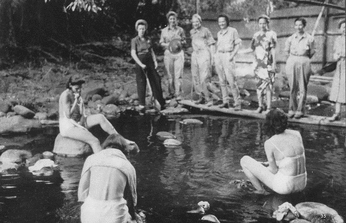 My part of the retreat was to share the inspiring story of the American WWII nurses who survived combat and Japanese prison camp. Their nursing vocation was important in giving them a purpose. It helped sustain them day after day as they suffered hunger and disease.
My part of the retreat was to share the inspiring story of the American WWII nurses who survived combat and Japanese prison camp. Their nursing vocation was important in giving them a purpose. It helped sustain them day after day as they suffered hunger and disease.And I spoke about the importance of identity. The nurses were strengthened by their identity as U.S. military women. We have the opportunity to dig deeper for our identity, to some core or passion within us that doesn’t not come from an outside label.
Labels fall away, or can be torn away. Our outer identity often depends on a job we do or a role we play. These can change over time, or in an instant.
Labels fall away,To be resilient in the business of writing for children, I've discovered I had better not pin my identity on getting published or having my books sell well. Yes, that happened for me with PURE GRIT. But I've been writing for more than 15-years and there were a lot of those when I did not get a book published.
or can be torn away.
What about you? Beyond the work you do and the roles you play, such as parent, partner, cook & bottle-washer, do you have an identity that does not depend on results you produce?
Published on January 16, 2015 16:08
January 8, 2015
Can you celebrate before the finish?
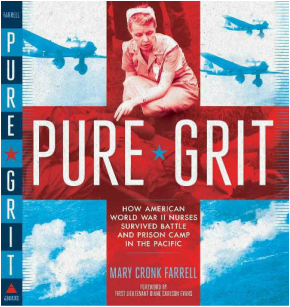 The final draft is almost never the final draft. That's what I learned in the process of publishing PURE GRIT.
The final draft is almost never the final draft. That's what I learned in the process of publishing PURE GRIT.There are so many details! Copy edits can take several run throughs. Then there are photo captions, end notes, first pass on the galleys (which is an unbound printout of the actual book) second pass on galleys...
It's kind of like life, when you think you've finally learned a lesson, finally got it right--then it comes round again.
I sent in my "final draft" of my next book, FANNIE NEVER FLINCHES, this past week, I knew I would see it again and again over the next year. But I celebrated anyway.
I celebrated even though there will probably be unexpected hitches in the process. Sometimes books at this stage get bumped out another year. If I wait to celebrate until the day I hold the finished book in my hands, I'll cheat myself many times of the satisfaction and joy that come with a job well done.
 We can all use more joy
We can all use more joy It's kind of like life. If I'm always leaning forward into what's coming, I'm missing the joy of what's right here now.
So I try to celebrate as often as I can. Sometimes the celebration is a simple pause to bask in the reality of the experience. A glass of champagne is nice, too!
After I clicked send on the final draft of my book last week, I sat in my living room and relaxed. For a few minutes I had nothing to do. I allowed myself the space to enjoy being finished. Being finished without thinking about the next task on my to-do list. That is an amazing feeling!
Sometimes I celebrate by giving myself time to read a YA novel all the way through in one sitting. Lots of my celebrations usually include food and friends. Pastries anyone?
How do you celebrate? How do you mark success, large and small?
Published on January 08, 2015 21:17
December 4, 2014
We Need More Heroes Like This Guy
It seems a fitting week to write about a man taking a stand against oppression, about the kind of courage that refuses to back down from the powers of violence and injustice.
We had a lovely guest for Thanksgiving dinner, a young woman from the Philippine Islands. I asked her what holidays she celebrated in that country, and she told me about National Hero Day, December 30th.
The day honors José Rizal, a man so at peace with himself and circumstances that he faced his execution without a hitch in his heartbeat. (Click to tweet) That's what the doctor said who checked Rizal's pulse as he faced the firing squad in 1896.
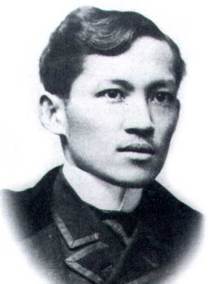 José was born and grew up Laguna, a farming community in the Philippines. His intelligence became apparent early and his family gave him the best education available.
José was born and grew up Laguna, a farming community in the Philippines. His intelligence became apparent early and his family gave him the best education available.
He decided study ophthalmology after his mother began to lose her eyesight. But due to discrimination against native Filipinos, Rizal was forced to leave his studies at Manila's Santo Tomas University. (American nurses were held at Santo Tomas when the Japanese made it a prison camp during WWII.)
At 21, Jose caught a ship to Spain and enrolled in the Universidad Central de Madrid to finish is medical degree. He earned a second doctorate at the University of Paris and a third in Germany. He excelled at whatever he put his mind to, including art, poetry, science, philosophy and architecture. Some say he spoke ten languages, others say the number is 22.
José Rizal became a prolific writer and blistering critic of Spanish colonialism, laying bare the cruelties inflicted on native Filipinos by Spanish and Church authorities. His books sparked fury and fear around the world among powerful elites with a vested interest in colonialism. In the Philippines, his books proved a catalyst for revolution.
In 1892, Rizal had returned to the Philippines and formed a group to work for reform through peaceful and legal means. He believed, that united, Filipinos could protect themselves from violence and injustice and gain freedom from Spanish oppression.

Using nonviolent protest more than 25-years before Mahatma Gandhi led his campaign of civil disobedience against the British Empire, Rizal led tenants to protest ever-increasing rents, evictions, and the destruction of Filipino farms.
His dauntless courage and his hope for Filipino freedom threatened the status quo. He was soon declared an enemy of the state, arrested and imprisoned. Without benefit of a trial, authorities deported Rizal to a remote town on the Philippine Island of Mindanao.
Dr Rizal Treating His Own Mother, Romeo Enriquez, 1960. Courtesy of the National Historical Institute, Manila, the Philippines
In 1896, after Rizal was allowed to return to Manila, Filipino liberationists revolted against the Spanish. Though he was not involved, Rizal was arrested, charged with sedition, conspiracy and rebellion. He was sentence to death with no chance to face is accusers or defend himself. Dr. Jose Rizal was executed by a firing squad, December 30, 1896. He was 35.
The Filipino revolution against Spain never fully succeeded, and when the United States won the Spanish American War, Rizal’s native land became a possession of the U.S. A year later Filipinos tried again for independence, the First Philippine Republic declaring war on the U.S.A. The effort was short-lived.
But later the U.S. Congress passed legislation forming a democratic government in the Philippines. One of Jose Rizal’s poems was read as evidence that Filipinos were not barbarians unable to govern themselves. Rizal penned My Last Farewell just hours before he faced the firing squad.
Am I a stone wasted on the field without becoming part of any edifice? Are you?
We had a lovely guest for Thanksgiving dinner, a young woman from the Philippine Islands. I asked her what holidays she celebrated in that country, and she told me about National Hero Day, December 30th.
The day honors José Rizal, a man so at peace with himself and circumstances that he faced his execution without a hitch in his heartbeat. (Click to tweet) That's what the doctor said who checked Rizal's pulse as he faced the firing squad in 1896.

 José was born and grew up Laguna, a farming community in the Philippines. His intelligence became apparent early and his family gave him the best education available.
José was born and grew up Laguna, a farming community in the Philippines. His intelligence became apparent early and his family gave him the best education available.He decided study ophthalmology after his mother began to lose her eyesight. But due to discrimination against native Filipinos, Rizal was forced to leave his studies at Manila's Santo Tomas University. (American nurses were held at Santo Tomas when the Japanese made it a prison camp during WWII.)
At 21, Jose caught a ship to Spain and enrolled in the Universidad Central de Madrid to finish is medical degree. He earned a second doctorate at the University of Paris and a third in Germany. He excelled at whatever he put his mind to, including art, poetry, science, philosophy and architecture. Some say he spoke ten languages, others say the number is 22.
José Rizal became a prolific writer and blistering critic of Spanish colonialism, laying bare the cruelties inflicted on native Filipinos by Spanish and Church authorities. His books sparked fury and fear around the world among powerful elites with a vested interest in colonialism. In the Philippines, his books proved a catalyst for revolution.
In 1892, Rizal had returned to the Philippines and formed a group to work for reform through peaceful and legal means. He believed, that united, Filipinos could protect themselves from violence and injustice and gain freedom from Spanish oppression.

Using nonviolent protest more than 25-years before Mahatma Gandhi led his campaign of civil disobedience against the British Empire, Rizal led tenants to protest ever-increasing rents, evictions, and the destruction of Filipino farms.
His dauntless courage and his hope for Filipino freedom threatened the status quo. He was soon declared an enemy of the state, arrested and imprisoned. Without benefit of a trial, authorities deported Rizal to a remote town on the Philippine Island of Mindanao.
Dr Rizal Treating His Own Mother, Romeo Enriquez, 1960. Courtesy of the National Historical Institute, Manila, the Philippines
“…our liberty will (not) be secured at the sword’s point…we must secure it by making ourselves worthy of it. And when a people reaches that height God will provide a weapon, the idols will be shattered, tyranny will crumble like a house of cards and liberty will shine out like the first dawn” – José RizalExile did not dampen Rizal’s fervor. In his four years of banishment, he built a school for boys, a hospital, water supply system and invented a machine for making bricks. He practiced medicine and scientific study, continued his artistic and literary works, farmed and kept up a wide correspondence with family and colleagues around the world.
In 1896, after Rizal was allowed to return to Manila, Filipino liberationists revolted against the Spanish. Though he was not involved, Rizal was arrested, charged with sedition, conspiracy and rebellion. He was sentence to death with no chance to face is accusers or defend himself. Dr. Jose Rizal was executed by a firing squad, December 30, 1896. He was 35.
The Filipino revolution against Spain never fully succeeded, and when the United States won the Spanish American War, Rizal’s native land became a possession of the U.S. A year later Filipinos tried again for independence, the First Philippine Republic declaring war on the U.S.A. The effort was short-lived.
But later the U.S. Congress passed legislation forming a democratic government in the Philippines. One of Jose Rizal’s poems was read as evidence that Filipinos were not barbarians unable to govern themselves. Rizal penned My Last Farewell just hours before he faced the firing squad.
"It is a useless life that is not consecrated to a great ideal. It is like a stone wasted on the field without becoming a part of any edifice."We need more heroes and heroines with courage like this. (Click to Tweet)
– José Rizal
Am I a stone wasted on the field without becoming part of any edifice? Are you?
Published on December 04, 2014 22:04
November 6, 2014
Born a Slave, Died A King
And Helped Fight for American Liberty in Between
Recently, I had the fortunate opportunity to accompany my husband on a business trip to Savannah, GA. There in the middle of a tree-lined square in the city's historic district, I came across this memorial statue and a story I'd never heard before. It was dark when I came upon it. But I could easily read the words carved in the stone of the memorial. They recounted how a group of mixed race men and boys sailed from what is now Haiti, to the colony of Georgia to join the American revolution. fight the rebel militia fight the British. Called the Chasseurs-Volontaires de Saint-Dominigue, these soldiers took part in the rebel mitia's effort to oust the British in Siege of Savannah.
It was dark when I came upon it. But I could easily read the words carved in the stone of the memorial. They recounted how a group of mixed race men and boys sailed from what is now Haiti, to the colony of Georgia to join the American revolution. fight the rebel militia fight the British. Called the Chasseurs-Volontaires de Saint-Dominigue, these soldiers took part in the rebel mitia's effort to oust the British in Siege of Savannah.
I came back in better light for more pictures. I was especially curious about the young drummer and the boy he represents, 12-year-old Henri Cristophe.
Born a slave on the Island of Grenada, how did Henri come to be at the Siege of Savannah?
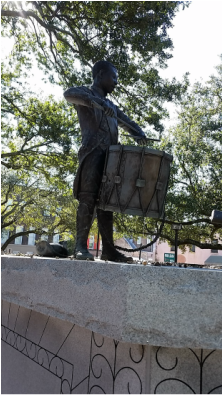 There is some debate about the circumstances of Cristophe's birth, but it's commonly believed that he was born a slave in Grenada. Young Henri escaped from his master and stowed away on a ship bound for the island Saint-Domingue (Haiti).
There is some debate about the circumstances of Cristophe's birth, but it's commonly believed that he was born a slave in Grenada. Young Henri escaped from his master and stowed away on a ship bound for the island Saint-Domingue (Haiti).
There he ended up serving a French naval officer, part of a French contingent that sailed for Georgia to aid the continental troops fighting for independence from the British.
The Siege of Savannah was a horrible rout for the French and continental militia, turning into the second deadliest battle of the Revolutionary War.
 Christophe escaped the battle with his life and some historians believe he then bought his freedom. Though he never learned to read and write he had a bent for leadership, and joined Black General Toussaint Louverture in wresting Haiti from the the colonial control of the French, English and Spanish.
Christophe escaped the battle with his life and some historians believe he then bought his freedom. Though he never learned to read and write he had a bent for leadership, and joined Black General Toussaint Louverture in wresting Haiti from the the colonial control of the French, English and Spanish.
Over the years, Christophe gained political clout and seized power, eventually declaring himself King of Independent Haiti. Despite his long commitment to ending slavery, he became a domineering King.
Haiti did prosper under his leadership, as Christophe helped developed a stable currency and strong trade. But the high-spirited boy who ran away from his master, had the chutzpah to marry his boss's daughter and the backbone to bargain with Napoleon Bonaparte's emissaries--died by his own hand when rebels seized his power.
In the end, Henri Christophe is not easy to categorize, which may be a good thing. I think we tend to categorize our leaders too easily.
The Chasseurs-Volontaires de Saint-Dominigue was the largest group of soldiers of African descent to fight in the American Revolution. It serves to reminds us of the spectrum of people who sacrificed to birth our country.
Recently, I had the fortunate opportunity to accompany my husband on a business trip to Savannah, GA. There in the middle of a tree-lined square in the city's historic district, I came across this memorial statue and a story I'd never heard before.
 It was dark when I came upon it. But I could easily read the words carved in the stone of the memorial. They recounted how a group of mixed race men and boys sailed from what is now Haiti, to the colony of Georgia to join the American revolution. fight the rebel militia fight the British. Called the Chasseurs-Volontaires de Saint-Dominigue, these soldiers took part in the rebel mitia's effort to oust the British in Siege of Savannah.
It was dark when I came upon it. But I could easily read the words carved in the stone of the memorial. They recounted how a group of mixed race men and boys sailed from what is now Haiti, to the colony of Georgia to join the American revolution. fight the rebel militia fight the British. Called the Chasseurs-Volontaires de Saint-Dominigue, these soldiers took part in the rebel mitia's effort to oust the British in Siege of Savannah.I came back in better light for more pictures. I was especially curious about the young drummer and the boy he represents, 12-year-old Henri Cristophe.
Born a slave on the Island of Grenada, how did Henri come to be at the Siege of Savannah?
 There is some debate about the circumstances of Cristophe's birth, but it's commonly believed that he was born a slave in Grenada. Young Henri escaped from his master and stowed away on a ship bound for the island Saint-Domingue (Haiti).
There is some debate about the circumstances of Cristophe's birth, but it's commonly believed that he was born a slave in Grenada. Young Henri escaped from his master and stowed away on a ship bound for the island Saint-Domingue (Haiti). There he ended up serving a French naval officer, part of a French contingent that sailed for Georgia to aid the continental troops fighting for independence from the British.
The Siege of Savannah was a horrible rout for the French and continental militia, turning into the second deadliest battle of the Revolutionary War.
 Christophe escaped the battle with his life and some historians believe he then bought his freedom. Though he never learned to read and write he had a bent for leadership, and joined Black General Toussaint Louverture in wresting Haiti from the the colonial control of the French, English and Spanish.
Christophe escaped the battle with his life and some historians believe he then bought his freedom. Though he never learned to read and write he had a bent for leadership, and joined Black General Toussaint Louverture in wresting Haiti from the the colonial control of the French, English and Spanish. Over the years, Christophe gained political clout and seized power, eventually declaring himself King of Independent Haiti. Despite his long commitment to ending slavery, he became a domineering King.
Haiti did prosper under his leadership, as Christophe helped developed a stable currency and strong trade. But the high-spirited boy who ran away from his master, had the chutzpah to marry his boss's daughter and the backbone to bargain with Napoleon Bonaparte's emissaries--died by his own hand when rebels seized his power.
In the end, Henri Christophe is not easy to categorize, which may be a good thing. I think we tend to categorize our leaders too easily.
The Chasseurs-Volontaires de Saint-Dominigue was the largest group of soldiers of African descent to fight in the American Revolution. It serves to reminds us of the spectrum of people who sacrificed to birth our country.
Published on November 06, 2014 12:28
October 9, 2014
My Take on Simplified & Sanitized
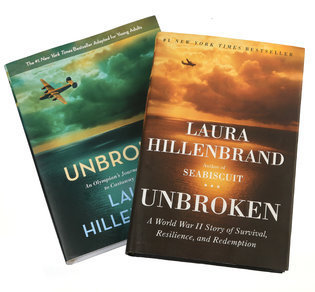 A twitter storm erupted and blew around the blogsphere the past couple days after The New York Times published the article To Lure Young Readers, Nonfiction Writers Sanitize and Simplify, by Alexandra Alter.
A twitter storm erupted and blew around the blogsphere the past couple days after The New York Times published the article To Lure Young Readers, Nonfiction Writers Sanitize and Simplify, by Alexandra Alter.At issue is Laura Hillenbrand’s new edition of her best seller UNBROKEN and a scene where a Japanese guard tortured and killed an injured duck.
"I know that if I were 12 and reading it, that would upset me," Ms. Hillenbrand said in the Times article.
A growing number of adult writers are writing cut down versions of their books for this market. Alter wrote “these slimmed-down, simplified and sometimes sanitized editions of popular nonfiction titles are fast becoming a vibrant, growing and lucrative niche”
The words “simplified and sometimes sanitized” caused much of the flack.
 YA Author Beth Kephart blogged:
YA Author Beth Kephart blogged: Let's first acknowledge what many young readers are capable of, which is to say, books rich with moral dilemma and emboldened by ideas. Let's next acknowledge what young readers need, which is to say the facts of then and now.
You can already get that sort of thing in novels written for younger readers. Certainly Patricia McCormick is not writing down, making it easy, simplifying when she writes about the sex trade or the Cambodian war….And certainly I, writing novels for young adults, am not setting history down in burnished, skip-over-it slices.
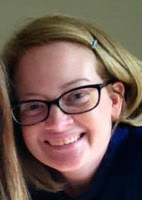 Librarian Liz Burns, who blogs for School Library Journal wrote: In a nutshell, my response: There is nothing wrong, and actually much right, with writing age-appropriate nonfiction books for children and teens. When and how subject matter is introduced and discussed is, well, the reason fifth graders aren't sent to university classes (unless they're Doogie Howser, of course.)
Librarian Liz Burns, who blogs for School Library Journal wrote: In a nutshell, my response: There is nothing wrong, and actually much right, with writing age-appropriate nonfiction books for children and teens. When and how subject matter is introduced and discussed is, well, the reason fifth graders aren't sent to university classes (unless they're Doogie Howser, of course.)In her longer response Liz Burns drew the distinction between books for children under 13, and books for teenagers. She also pointed to what I see as the more fundamental and important issue—getting appropriate books to readers no matter what their age, and our lack of commitment to that end.
Schools are increasing their purchasing of nonfiction at a time when the resources to do so have been reduced. Funding for books is decreased; and professional librarians, who evaluate and find books, have reduced hours, increased responsibilities, or have been eliminated all together.
Perhaps this is all just a flap over a few sensational words in the news, but even so, it’s an opportunity to ask ourselves if we really mean it when we say we want kids to read more, and if they deserve quality books, and librarians to get the right book, at right time, into a child’s hands.
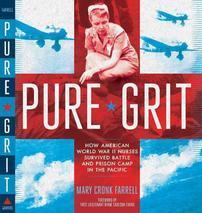 I can't close without sharing the Washington Post's words about PURE GRIT.
I can't close without sharing the Washington Post's words about PURE GRIT.Farrell doesn’t spare her young readers any grim details . . . She includes the challenges these women faced and the joy they felt on returning home. As awful as history can be, now might be the right time to introduce the next generation to this important period.
--The Washington Post
Published on October 09, 2014 09:14
October 3, 2014
Two Woman who stood in the Gap between Rich and Poor.
Fannie Sellins is back! I'm working on the final edits of her biography scheduled for release in 2016, nine years and many revisions after I began the project.
Fannie Sellins entered my life via a Google search on American labor history back in 2007--In the Midst of Terror She went out to Her Work was one entry that turned up.
Who could pass on that? Not me. The article by Mary Lou Hawse started like this: "Fannie Sellins was a labor organizer -- and from all accounts, she was an exceptional one. But she paid with her life."
Suffice it to say, I was off like a bloodhound tracking scent and by the end of the day, I was determined to write a book about this woman.
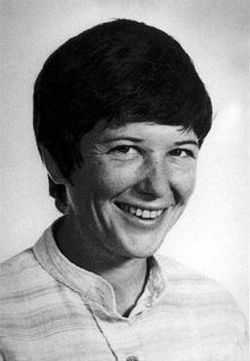 Ita Ford She reminded me of Ita Ford, one of the Maryknoll sisters brutally murdered by national guardsmen in El Salvador in 1980.Both women shared a love for the poor, selfless courage, and a focus on people's everyday needs while working for systemic change.
Ita Ford She reminded me of Ita Ford, one of the Maryknoll sisters brutally murdered by national guardsmen in El Salvador in 1980.Both women shared a love for the poor, selfless courage, and a focus on people's everyday needs while working for systemic change.
Ita chose to work in El Salvador, where a small minority controlled the vast majority of the country's wealth and most people lived in poverty. She was fully aware of the death squads raining violence on those who spoke out against the system, including the Catholic Archbishop of El Salvador Oscar Romero who was assassinated while saying Mass.
Ita believed deeply in Romero's words, "one who is committed to the poor must risk the same fate as the poor. And in El Salvador we know what the fate of the poor signifies: to disappear, to be tortured, to be captive and to be found dead."
In 1913-14, Fannie Sellins made her home among the destitute miners’ families in the nonunion coal fields of West Virginia. The United Mine Workers Journal called her an "Angel of Mercy," who went into the miners' homes, encouraging their wives and caring for the sick and dying. "Whenever there was a strike, with its inevitable suffering, Mrs. Sellins was found, caring for the women and children through the dark days of the struggle."
Threatened with arrest for urging miners to join the union, Fannie said, “The only wrong that they can say I have done is to take shoes to the little children in Colliers who need shoes. And when I think of their little bare feet, blue with the cruel blasts of winter, it makes me determined that if it be wrong to put shoes upon those little feet, then I will continue to do wrong as long as I have hands and feet to crawl to Colliers.”
 West Virginia Strikes and Families evicted & living in tents. Courtesy National Archives. When the miners’ union was crushed in West Virginia, Fannie moved to Pennsylvania’s Black Valley, they called it the Black Valley. The name sprang from the fighting between labor unions and mine owners. Fighting so fierce, they called it war. Labor war.
West Virginia Strikes and Families evicted & living in tents. Courtesy National Archives. When the miners’ union was crushed in West Virginia, Fannie moved to Pennsylvania’s Black Valley, they called it the Black Valley. The name sprang from the fighting between labor unions and mine owners. Fighting so fierce, they called it war. Labor war.
In late summer 1919, miners struck Allegheny Coal and Coke in Brackenridge, PA. Fannie was warned to leave town if she valued her life. She stayed. She walked the picket lines with the men and rallied strikers to stick it out.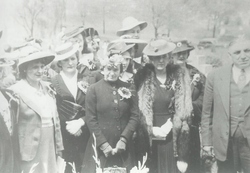 Women at Fannie Sellins Funeral, St. Peter’s Church, New Kensington PA She tried to keep peace, while the two sides heckled each other and often came to blows.
Women at Fannie Sellins Funeral, St. Peter’s Church, New Kensington PA She tried to keep peace, while the two sides heckled each other and often came to blows.
One afternoon an argument broke out between sheriff’s deputies and an unarmed miner. A crowd gathered, including Fannie, seeing deputies club, then shoot and kill the man. She shouted for the lawmen to stop. They turned on her, gunning her down as she tried to herd nearby children to safety.
Ita and Fannie did not give their lives in some grand gesture of generosity and selflessness, they simply got up each morning and did the work that was before them. For Ita, it was driving people where they needed to go in the rocky hills of El Salvador, or delivering medicine and food. For Fannie, it was helping a poor woman in labor or encouraging workers to believe they deserved better. They stood with the poor and powerless with such integrity that those with power and wealth could not allow them to live.
For more on the men who ordered Ita's death click here.
For the rest of the story on Fannie, you'll have to wait for the book. :)
Fannie Sellins entered my life via a Google search on American labor history back in 2007--In the Midst of Terror She went out to Her Work was one entry that turned up.
Who could pass on that? Not me. The article by Mary Lou Hawse started like this: "Fannie Sellins was a labor organizer -- and from all accounts, she was an exceptional one. But she paid with her life."
Suffice it to say, I was off like a bloodhound tracking scent and by the end of the day, I was determined to write a book about this woman.
 Ita Ford She reminded me of Ita Ford, one of the Maryknoll sisters brutally murdered by national guardsmen in El Salvador in 1980.Both women shared a love for the poor, selfless courage, and a focus on people's everyday needs while working for systemic change.
Ita Ford She reminded me of Ita Ford, one of the Maryknoll sisters brutally murdered by national guardsmen in El Salvador in 1980.Both women shared a love for the poor, selfless courage, and a focus on people's everyday needs while working for systemic change.Ita chose to work in El Salvador, where a small minority controlled the vast majority of the country's wealth and most people lived in poverty. She was fully aware of the death squads raining violence on those who spoke out against the system, including the Catholic Archbishop of El Salvador Oscar Romero who was assassinated while saying Mass.
Ita believed deeply in Romero's words, "one who is committed to the poor must risk the same fate as the poor. And in El Salvador we know what the fate of the poor signifies: to disappear, to be tortured, to be captive and to be found dead."
In 1913-14, Fannie Sellins made her home among the destitute miners’ families in the nonunion coal fields of West Virginia. The United Mine Workers Journal called her an "Angel of Mercy," who went into the miners' homes, encouraging their wives and caring for the sick and dying. "Whenever there was a strike, with its inevitable suffering, Mrs. Sellins was found, caring for the women and children through the dark days of the struggle."
Threatened with arrest for urging miners to join the union, Fannie said, “The only wrong that they can say I have done is to take shoes to the little children in Colliers who need shoes. And when I think of their little bare feet, blue with the cruel blasts of winter, it makes me determined that if it be wrong to put shoes upon those little feet, then I will continue to do wrong as long as I have hands and feet to crawl to Colliers.”
 West Virginia Strikes and Families evicted & living in tents. Courtesy National Archives. When the miners’ union was crushed in West Virginia, Fannie moved to Pennsylvania’s Black Valley, they called it the Black Valley. The name sprang from the fighting between labor unions and mine owners. Fighting so fierce, they called it war. Labor war.
West Virginia Strikes and Families evicted & living in tents. Courtesy National Archives. When the miners’ union was crushed in West Virginia, Fannie moved to Pennsylvania’s Black Valley, they called it the Black Valley. The name sprang from the fighting between labor unions and mine owners. Fighting so fierce, they called it war. Labor war.In late summer 1919, miners struck Allegheny Coal and Coke in Brackenridge, PA. Fannie was warned to leave town if she valued her life. She stayed. She walked the picket lines with the men and rallied strikers to stick it out.
 Women at Fannie Sellins Funeral, St. Peter’s Church, New Kensington PA She tried to keep peace, while the two sides heckled each other and often came to blows.
Women at Fannie Sellins Funeral, St. Peter’s Church, New Kensington PA She tried to keep peace, while the two sides heckled each other and often came to blows. One afternoon an argument broke out between sheriff’s deputies and an unarmed miner. A crowd gathered, including Fannie, seeing deputies club, then shoot and kill the man. She shouted for the lawmen to stop. They turned on her, gunning her down as she tried to herd nearby children to safety.
Ita and Fannie did not give their lives in some grand gesture of generosity and selflessness, they simply got up each morning and did the work that was before them. For Ita, it was driving people where they needed to go in the rocky hills of El Salvador, or delivering medicine and food. For Fannie, it was helping a poor woman in labor or encouraging workers to believe they deserved better. They stood with the poor and powerless with such integrity that those with power and wealth could not allow them to live.
For more on the men who ordered Ita's death click here.
For the rest of the story on Fannie, you'll have to wait for the book. :)
Published on October 03, 2014 00:00
September 25, 2014
Will We Abandon Our Wounded Warriors?
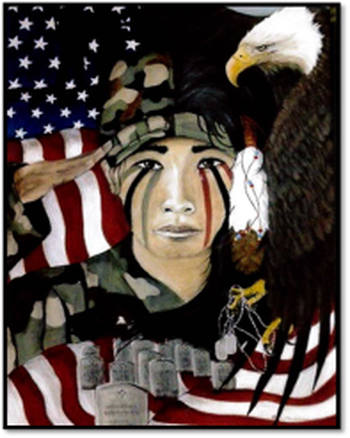 Painting by Pam Evenson Listen up to these words from an American woman combat veteran, Lt. Colonel Madeline Ullom.
Painting by Pam Evenson Listen up to these words from an American woman combat veteran, Lt. Colonel Madeline Ullom.“I have a great reluctance now to apply for further disability because I am acutely aware that such application results only in a hassle. …the stories I hear concerning applications for further disability have long ago discouraged me. Further, I know dozens of my nurse companions who have made application and have met with nothing but opposition.”
Lt. Colonel Ullom was a former POW and veteran of WWII.
 U.S. Army Photo 1945 In the news today… the Disabled American Veterans identified serious gender gaps in virtually every program serving veterans, including health care, job training, finance, housing, social issues and combating sexual assault.
U.S. Army Photo 1945 In the news today… the Disabled American Veterans identified serious gender gaps in virtually every program serving veterans, including health care, job training, finance, housing, social issues and combating sexual assault.About 1 in 5 female veterans have delayed or gone without needed medical care in the prior 12 months, the report said.
Has nothing changed in 70-years?
In 1956 when former WWII POW Major Maude Davison suffered a massive stroke that left her in a coma, the local Veteran’s Administration Hospital refused to care for her. Her husband had to petition the regional VA office to get her a bed.
This week Joy Ilem, DAV's deputy national legislative director said female veterans "deserve equal respect, consideration and care as the men who served, yet the support systems are ill-equipped to meet the unique needs of the brave women who have defended our country."
"At a time when the number of women veterans is growing to unprecedented levels, our country is simply not doing enough to meet their health, social and economic needs," she said.
A sharp increase in reporting of military sexual trauma is an illustration of problems that require "radical change" at the VA and throughout the military, the DAV report says.
What do you think? Whose responsibility is it to make sure women veterans get the health care and other services they need?
Published on September 25, 2014 21:07
September 11, 2014
The Courage to Forgive
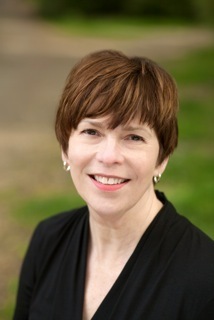 Today welcome Newbery Honor Author Kirby Larson, who's agreed to share her thoughts about courage.
Today welcome Newbery Honor Author Kirby Larson, who's agreed to share her thoughts about courage.Growing up, I associated courage with brave deeds and actions: John Glenn for rocketing to the moon, my cousin for diving off the high board, and, of course, Napoleon Solo and Illya Kuryakin for fighting the evil agents of CHAOS. As a comic book and movie lover, it’s not surprising that I thought the way I did. People admired Batman for swooping in to foil the Joker; John Wayne may not have always gotten the girl, but he almost always won the gunfight or the battle.
This is no earth-shattering revelation, but of course those romanticized and Hollywood influenced versions of courage only tell one small slice of the story. Once I came to understand that my true writing passion is historical fiction, my reading and research revealed to me many, many examples of genuine courage.
Sometimes the expression of courage is a small thing: a busy construction worker who cared for a stray dog and cat after Hurricane Katrina ravaged New Orleans, despite his boss’ disapproval. This courageous (and kind) action inspired Mary Nethery and me to write Two Bobbies: A True Story of Hurricane Katrina, Friendship and Survival.
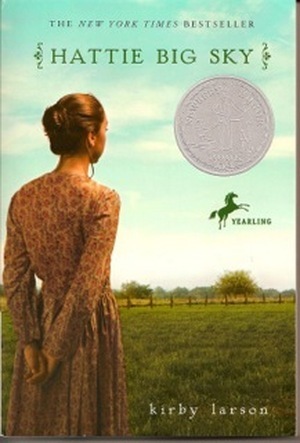 Sometimes people are courageous in large ways, like my great-grandmother and others like her who dared to homestead by themselves during the early 1900s, inspirations for my novel Hattie Big Sky.
Sometimes people are courageous in large ways, like my great-grandmother and others like her who dared to homestead by themselves during the early 1900s, inspirations for my novel Hattie Big Sky. Or like Reverend Emery Andrews who, at tremendous personal cost, not only spoke out against the “relocation” of people of Japanese descent during WWII, he left his church and uprooted his family to Twin Falls, Idaho, to help those who were incarcerated in Minidoka War Relocation Camp. Though he was spit upon, shoved out of cafes and even evicted from his first Twin Falls home, he never faltered in his desire and efforts to help. Thinking about what it would have been like to have such a man for a father led me to write The Fences Between Us.
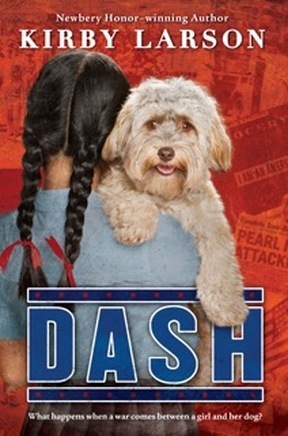 Recently, at an event to help launch my new book, Dash, I met a woman who has me looking at courage from a different perspective. Her name is Kay Sakai Nakao and when she was 22, she and her family were evacuated from Bainbridge Island, Washington and sent to a war relocation camp.
Recently, at an event to help launch my new book, Dash, I met a woman who has me looking at courage from a different perspective. Her name is Kay Sakai Nakao and when she was 22, she and her family were evacuated from Bainbridge Island, Washington and sent to a war relocation camp. Kay gave birth to her first child in the camp; after the delivery, she brought her infant “home” to rough barracks, equipped only with Army-supplied cots and a pot belly stove. Any other furniture in the “apartment” was made from scavenged scrap wood. With a babe in arms, Kay waited in long lines for meals – slogging through mud in winter, wilting in blistering heat and dust in summer – and at the latrines, (initially nothing more than modesty-robbing ten-hole outhouses) and laundry house. Can you imagine washing diapers in such an environment?
Kay is now in her 90s and I was present when someone asked her if she was bitter or angry about what had happened to her as a young mother. (I agreed with the asker that I certainly would have been!). Kay smiled a gentle and serene smile and said that she had long ago realized that the only person hurt by holding a grudge or being bitter was herself. “I choose to live with joy,” she said.
When I think about all she lived through and all she has to be angry about, Kay’s life philosophy seems to me the supreme definition of courage.
Thank you, Kirby! I love being reminded that joy is a choice. What about you? Have you faced a difficult time choosing to forgive someone? Do you remember a time when you made a definite choice for joy, rather than resentment or frustration?
To learn more about Kirby Larson and her books click here.
You can follow her on twitter, too. @KirbyLarson
Published on September 11, 2014 20:56



